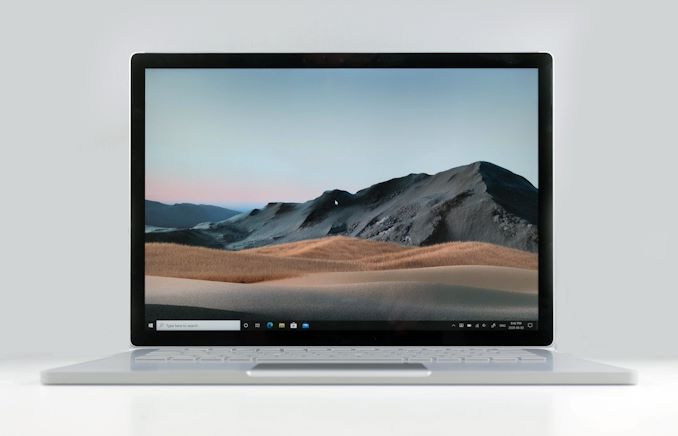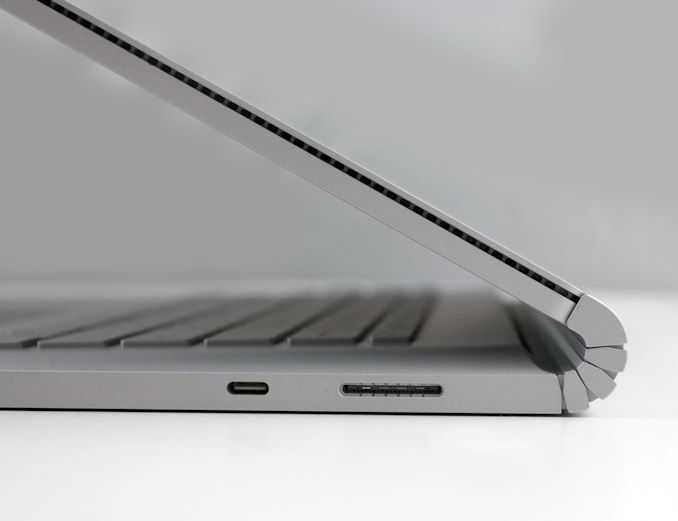The Microsoft Surface Book 3 (15-Inch) Review: A Refreshing Dip Into Ice Lake
by Brett Howse on June 3, 2020 9:00 AM EST
The PC industry has introduced some remarkably exciting designs over the last five years or so. Some of those designs, such as the thin-bezel laptop, have been adopted by almost all players in the industry. Microsoft has certainly been an innovator in the space as well, and the Surface Pro series has become the baseline for an entire category that did not exist in any volume before their launch.
But almost certainly, one of the quirkiest designs to come out of the Surface group has been the Surface Book. First launched in 2015, the Surface Book took an unusual approach to convertible laptops, incorporating an electromechanically detachable screen, and putting processors in both halves of the laptop. The original Surface Book was succeeded by the Surface Book 2 in 2017, and recently Microsoft launched the third generation of their most powerful notebook computer.
With Surface Book 2, Microsoft first introduced the 15-inch version of the notebook, and for 2020, the company is continuing to offer both 13.5-inch and 15-inch models. The electromechanically detachable tablet portion is certainly the highlight feature, and one which the entire design hinges on, pun intended. Microsoft’s Dynamic Fulcrum hinge, which expands the footprint of the base as the laptop is opened, is what provides the Surface Book with its very unique look and feel. Fittingly, for Surface Book 3, Microsoft has opted to keep chassis virtually identical to its predecessor.
Instead the Surface Book 3 is all about the internal upgrades, and they are all significant. The new Book gets an infusion of Intel's Sunny Cove CPU architecture in the form of their newest Ice Lake platform. Built on the company's 10 nm process, it is the first major architectural change since 2015's Skylake, and brings with it more performance, better power management, and a much-improved iGPU. Microsoft has also included the latest NVIDIA GPUs targeting laptops in 2020, with the smaller 13.5-inch Surface Book 3 offering an optional GeForce GTX 1650 Max-Q, while the larger 15-inch model sports the GeForce GTX 1660 Ti Max-Q, both of which are nice steps up in performance over the previous generation's GTX 1050, and GTX 1060 offerings. Also in a first for Surface, the new Book 3 is also optionally available with a NVIDIA Quadro RTX 3000, one of the company's professional-focused GPUs.
The move to Ice Lake also means that for the first time, the Surface Book 3 is now available with up to 32 GB of LPDDR4X RAM, double the maximum capacity versus the previous generation. The 16 GB limit was a function of previous Intel laptop CPUs only supporting LPDDR3, and for a laptop that competes against powerful opponents, this is an important addition.
| Microsoft Surface Book 3 | |||||
| 13.5 No GPU | 13.5 GPU | 15 As configured: 32GB / 512GB / $2799.99 |
|||
| CPU | Intel Core i5-1035G7 Quad-Core w/Hyperthreading 1.2-3.7 GHz 6MB Cache 15W TDP |
Intel Core i7-1065G7 Quad-Core w/Hyperthreading 1.3-3.9 GHz 8MB Cache 15W TDP |
|||
| RAM | Up to 32GB LPDDR4X | ||||
| GPU | Intel Iris Plus G7 | Intel Iris Plus G7 + NVIDIA GTX 1650 Max-Q 4GB | Intel Iris Plus G7 + NVIDIA GTX 1660Ti Max-Q 6GB | ||
| Storage | 256 GB to 2 TB | ||||
| Display | 13.5" PixelSense 3000x2000 3:2 sRGB Touch and Pen enabled |
15" PixelSense 3240x2160 3:2 sRGB Touch and Pen enabled |
|||
| Networking | Wi-Fi 6 802.11ax Bluetooth 5.0 |
||||
| Audio | Stereo Speakers (front facing) Dolby Audio Premium |
||||
| Battery | 78 Wh / 103 W AC | 85 Wh / 127 W AC | |||
| Xbox Wireless | No | Yes | |||
| Right Side | Surface Connect USB Type-C 3.2 Gen 2 with USB Power Delivery Headset Jack |
||||
| Left Side | 2 x USB 3.2 Gen 2 Type-A SD Card Reader |
||||
| Dimensions | 312 x 232 x 13-23mm 12.3 x 9.14 x 0.51-0.90 inches |
343 x 251 x 15-23 mm 13.5 x 9.87 x 0.57-0.90 inches |
|||
| Weight | 1.53 kg 3.38 lbs |
1.64 kg 3.62 lbs |
1.90 kg 4.2 lbs |
||
| Cameras | 8.0 MP Rear-facing camera with autofocus 5.0 MP front-facing camera with 1080p video Windows Hello IR camera |
||||
| Pricing | Starting at $1599.99 USD | Starting at $2299.99 USD | |||
Although Microsoft still seems reluctant to include Thunderbolt 3 support, they did add a USB Type-C connector on the previous Surface Book 2. That port is now upgraded to USB 3.2 Gen 2, as are the Type-A ports. The Surface Connect charging / docking connector also gets a substantial upgrade as well, and now finally allows two UHD 60 Hz display connections via the new Surface Dock.
As for wireless connectivity, Microsoft if finally moving away from Marvell network adapters as well. As a result, the Surface Book 3 goes all-Intel, using the company's AX201 adapter with Wi-Fi 6.
Past this, the Surface Book 3 sees a relatively minor refresh for 2020, with no cosmetic changes, but certainly welcome changes under the hood. When the Surface Book first launched, it was one of the most interesting laptops on the market. Now, five years later, let us see how that design holds up with some fresh internals.











125 Comments
View All Comments
zepi - Thursday, June 4, 2020 - link
How was batterylife in tablet mode without the base?Brett Howse - Friday, June 5, 2020 - link
Sorry I had tested that but forgot to add it to the graphs. It's there now.Wrong_again - Thursday, June 4, 2020 - link
It seems like an unpopular opinion but tablet devices should not have tiny bezels. For reasons that seem obvious to me.Retycint - Thursday, June 4, 2020 - link
The iPad Pro manages to have smaller bezels while not significantly affecting the usability. Smaller bezels does not necessarily mean tiny bezelss.yu - Thursday, June 4, 2020 - link
There's clearly a gap between this and "tiny". Also, again, the XPS 13 2N1 has a perfectly functional screen with arguably "tiny" bezels.PeachNCream - Thursday, June 4, 2020 - link
Tablets aren't really even a thing anymore. Hardly any company makes a credible attempt at producing one outside of the usual iFruits and Microsoft (I guess Google has Chrome-based hardware too if you like giving your personal information to the creepiest company on the planet). There are still a few 2-in-1 systems around and ultra low budget Android devices, plus a couple of laptops with questionably glossy touchscreens for reasons only the OEM can fully understand, but in general terms, tablets - Windows ones moreso than others - have been taken out back and shot, then tossed into a shallow grave with a bunch of other tech fads that failed to take enduring root.It is unexpected to watch Microsoft continue to release new models in a form factor that is laying in the desert, gasping its last parched air before failing to pull a Clint Eastwood-style survival montage. They already transitioned partly to clamshell designs to hedge the Surface brand name. It really is odd to see them clinging to the touch-everywhere bad old days of Windows 8.
lazybum131 - Thursday, June 4, 2020 - link
"It really is odd to see them clinging to the touch-everywhere bad old days of Windows 8."If only Microsoft actually did, then the tablet experience with Win 10 wouldn't be so poor. On Windows pure and detachable tablets aren't strong because the tablet experience just isn't good or polished even for built-in basic functions, let alone the barren app Store. Add in the slow progress on low-tdp chips that would actually enable portable designs.
lmcd - Thursday, June 4, 2020 - link
Intel's Lakefield could change the story there -- aside from the Intel tax with the experimental-technology surcharge, it could fit in 8 inch tablets. Based on the Surface Neo delay, I'd assume it's using a Lakefield chip.Microsoft's lack of good tablet software in the store boils down to the .NET team absolutely ignoring everything the Windows team would prioritize. Windows 10X doubles down on UWP while the .NET team hasn't released an up-to-date AOT compiler and C# project format in over 2 years.
Deicidium369 - Friday, June 5, 2020 - link
I will probably use the tablet mode on the 13 2-in-1 about as much as on the previous model - not much at all - but when needed (stocking up at a Spec's type place for a party) it is very useful. But yeah the time of the tablets looks to be over.Deicidium369 - Friday, June 5, 2020 - link
would be obvious 1st time it got dropped...